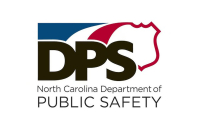Honoring a lost art
By Kristen Davis • Contributing Writer
The newest piece of public art in downtown Waynesville — a metal railing that depicts a mountain scene — could have been crafted centuries ago.
The artists, Richard Coley and Ben Kastner of Wilmington decided to forego modern technology and built the structure using traditional blacksmithing techniques. Starting with 20-foot pieces of metal, Coley and Kastner heated up the metal in a forge and then hammered each bar into their desired shape. No corners were cut with modern machines; even the holes in the metal were hand-punched rather than drilled.
“[Blacksmithing] is a lost art,” Kastner said. “With the machine age, everyone went to machine parts. We’re trying to take it back to the simpler way of doing it. When it’s handmade, you can really see the craftsmanship.”
What used to be straight pieces of metal are now twisted elegantly into a mountain skyline with trees, a church steeple, and three salamanders in honor of the Great Smoky Mountains as the “Salamander Capital of the World.”
The railing will be installed at the mini-park near the corner of Main and Depot streets this week. The intersection holds historic significance as the site that was once overlooked by a large arched sign that indicated the eastern entrance of Great Smoky Mountains National Park. Franklin D. Roosevelt rode beneath the sign on his way to the dedication ceremony for the park in 1934. These aspects of the town’s history inspired the Waynesville Public Art Commission’s theme for the railing — “Art Connects the Parks.”
Related Items
Kastner explained that the installation could take one to three days.
“Installs are something you never really know what you’re getting until you get there,” he said. “We have to drill these 3-inch holes in the wall, so there could be unseen obstacles at the job site.”
Unexpected setbacks notwithstanding, the artists plan to have the railing installed by the dedication ceremony, which will occur at 4:30 p.m. on Friday, Nov. 19, at Gallery 86. According to Kaaren Stoner, the public art commission chairman, the ceremony will last about a half hour, and the featured speakers will include: Mayor Gavin Brown; a representative from Smoky Mountain National Park; Bill King, vice chairman of the Public Art Commission; and the two artists.
This project is the first public art commission Kastner and Coley have received. Kastner called it “one of the best opportunities” he and their shop have ever had. They were selected for the commission after responding to the Waynesville Public Art Commission’s call for artists throughout North Carolina and Tennessee to design a railing that could represent downtown Waynesville’s historic connection to Great Smoky Mountain National Park, beating out the other 25 artists who applied.
Kastner said he and his business partner/fellow artist/friend have been working 12 to 15 hour days to finish the project by their deadline.
“People will enjoy it for years to come, so I don’t mind spending the extra time when so many people can enjoy it,” he said. “It’s rewarding to think that it’s not just for one homeowner to enjoy behind closed doors.”
Kastner’s interest in metal-working sparked in high school when he took a welding class outside of his regular class schedule. Eventually, he and Coley, his friend since high school, attended the College of Oceaneering in California to learn underwater welding. While there, they both worked part-time at a blacksmith shop, which reoriented their interest toward more traditional ironworks.
“There’s only so much you can do with welding,” Kastner said.
He prefers the challenge that blacksmithing provides him.
“You can always get better at it, you can always learn more,” he said. “It’s always exciting to think about the things you can learn from other people. It’s not the same thing everyday like your average job.”
The “Art Connects the Parks” project is the third major public art installation to grace the streets of downtown Waynesville, thanks to the efforts of the Public Art Commission. The first project “Old Time Music,” constructed by Stefan Bonitz, was installed on the corner of Miller and Main Streets in 2008 and features two rosy-cheeked, grinning musicians — one playing banjo and the other on a washtub bass. The second project “Celebrating Folkmoot,” by renowned public artist Wayne Trapp, waves its flags in the wind on the corner of Main and East streets.
The public purse was not opened for any of the three public art projects. All were funded with private donations, Stoner said. The $20,000 commission for “Art Connects the Parks” comes from individuals, local businesses and a grant from the Haywood County Tourism.
This past June, the Public Art Commission raised much of the commission funds with its “Salamander Splash” event at HART Theater, where there was an art auction of more than 48 works of art — paintings, jewelry, pottery, quilted wall art and metal — all featuring the “Salamander Capital of the World” theme and made by Haywood County artists.
The Waynesville Public Art Commission, established in 2006, evolved out of the StreetScapes Committee, which raised funding for rotating temporary art for the town’s public spaces from 1999 to 2004. The success of the StreetScapes initiative caused enthusiasm for implementing permanent public art.
“I’d like to thank the town for giving us this opportunity,” Kastner said. “It’s opened some doors and changed the course we’re heading by getting us away from the architectural side of things and into public art. We feel like there’s more of a purpose to it because more people can enjoy it.”
Since receiving their first public art commission, Coley and Kastner applied for another one in Kinston, for which they are designing a bandstand to honor the African American Music Trail. They were selected as finalists and will turn in their design next week, Coley said.









